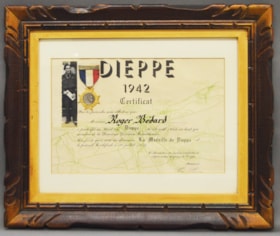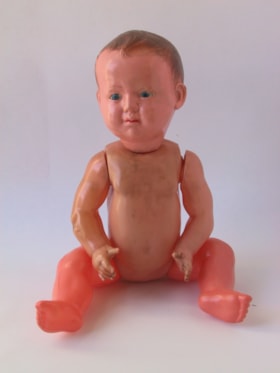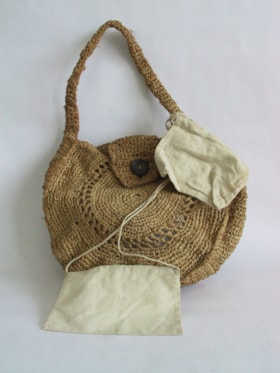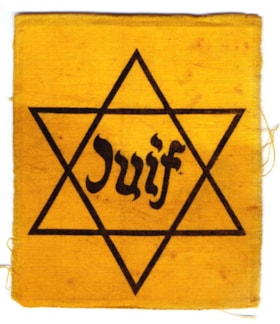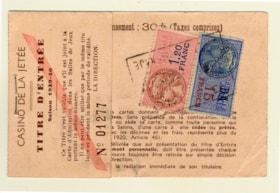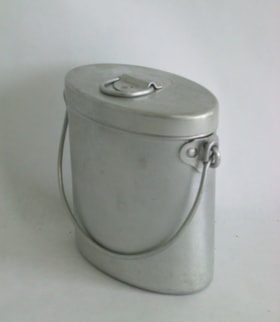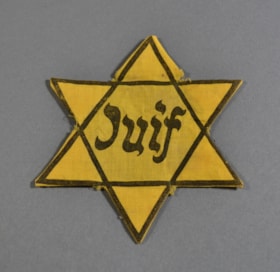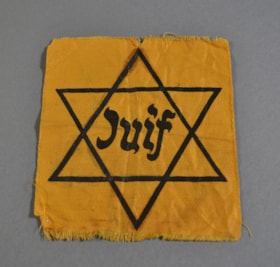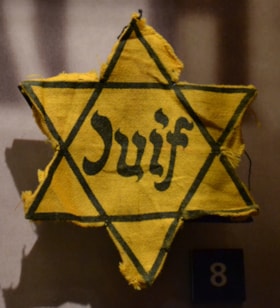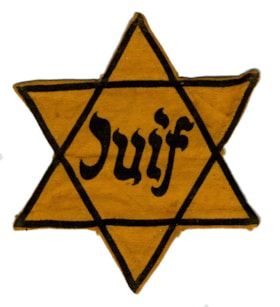Armband
https://www.cjhn.ca/link/cjhn47505
- Collection
- Montreal Holocaust Museum
- Description Level
- Item
- Material Type
- object
- Physical Description
- Armband : woven, sewn, machine, printed : beige, black
- Date
- 1939-1940
- Collection
- Montreal Holocaust Museum
- Description Level
- Item
- Material Type
- object
- Physical Description
- Armband : woven, sewn, machine, printed : beige, black
- Other Title Information
- Personal Symbol
- Date
- 1939-1940
- Physical Condition
- Poor
- Language
- French
- Notes
- The centre of the band is wider than the ends. Button holes are found on the left side, with an additional loop of fabric. The armband belonged to the donor's father, Maurice Elias Narrative: Maurice Elias volunteered for the French Army on September 11, 1939 although he was not a French citizen. On March 20, 1940 he joined the 212 Infantry Division and was demobilized in 1941. The family received his cap and armband after liberation. They had been left behind when he was demobilized. He owned a store since 1933, which was assigned an administrator. He was taken on August 20, 1941 in the first round-up of Paris Jews (mostly professionals and intellectuals). He was picked up at 6:30 AM by 3 French men and taken to Drancy. Transferred to Compiegne because they thought that he was a Communist since he spoke Russian. On February 27, 1942 he was deported to Auschwitz and killed April 19, 1942
- Accession No.
- 2000.34.08
- Name Access
- Elias, Marguerite
- Places
- France, Europe
- Archival / Genealogical
- Archival Descriptions
- Repository
- Montreal Holocaust Museum
Images
Armband
https://www.cjhn.ca/link/cjhn51219
- Collection
- Montreal Holocaust Museum
- Description Level
- Item
- Material Type
- object
- Physical Description
- Armband : printed, embroidered : White, Black ; Ht: 3,75 in. x W: 12,5 in.
- Date
- 1939-1945
- Collection
- Montreal Holocaust Museum
- Description Level
- Item
- Material Type
- object
- Physical Description
- Armband : printed, embroidered : White, Black ; Ht: 3,75 in. x W: 12,5 in.
- Other Title Information
- Personal Symbol
- Date
- 1939-1945
- Physical Condition
- Good
- Language
- German
- Notes
- Rectangular armband with three snaps. It served as identification for a forced labourer. This armband was given in Drancy internment camp to a hungarian Jew named Pal Link. Narrative: This armband belonged to Pal Link, the donor's father. In 1940, Pal was away from his home and family in Budapest for business and found himself stuck in France when the Germans invaded the country. He fled to Normandy hoping to escape to England but was unsuccessful. With false papers given to him by a local policeman, he managed to reach Nice in the South of France. Once the free zone was invaded, Pal went into hiding in the Alps but was denounced and deported to the Drancy internment camp. On the way to the camp, a soldier advised him to lie about his employment. Pal had a business exporting agricultural products but declared he was a stoker, and was put to work as such. This is how he survived from the end of 1943 to the summer of 1944 when the last inmates were let go in exchange for German soldiers. Pal survived the Holocaust and immigrated to Montreal where his son, Andre was living.
- Accession No.
- 2011X.221.01
- Name Access
- Link, André
- Places
- Drancy, France, Europe
- Archival / Genealogical
- Archival Descriptions
- Repository
- Montreal Holocaust Museum
Images
Belt
https://www.cjhn.ca/link/cjhn47536
- Collection
- Montreal Holocaust Museum
- Description Level
- Item
- Material Type
- object
- Physical Description
- Belt : leather worked, braided, sewn (machine), pegged : red, silver
- Collection
- Montreal Holocaust Museum
- Description Level
- Item
- Material Type
- object
- Physical Description
- Belt : leather worked, braided, sewn (machine), pegged : red, silver
- Other Title Information
- Clothing Accessory
- Physical Condition
- Good
- Notes
- Silver buckle on one end; the other end is a piece of flat leather with 3 layers for reinforcement; 5 buckle holes are going along the centre in a line. The waist band is made up of 3 separate braided cords; 3 belt loops are positioned along the waist band in different intervals, keeping the cords connected, with an additional loop near the buckle. Narrative: This belt was a birthday gift from the donor's mother to her on the occasion of her 13th birthday (July 15, 1943) in Cannes.
- Accession No.
- 2011X.215.11
- Name Access
- Levy, Rachel
- Places
- Cannes, France, Europe
- Archival / Genealogical
- Archival Descriptions
- Repository
- Montreal Holocaust Museum
Images
Bottle
https://www.cjhn.ca/link/cjhn45709
- Collection
- Montreal Holocaust Museum
- Description Level
- Item
- Material Type
- object
- Physical Description
- Bottle : painted : multi-coloured ; Ht: 21,7 cm x W: 7,5 cm
- Date
- 1941-1944
- Collection
- Montreal Holocaust Museum
- Description Level
- Item
- Material Type
- object
- Physical Description
- Bottle : painted : multi-coloured ; Ht: 21,7 cm x W: 7,5 cm
- Other Title Information
- Decorative Art
- Date
- 1941-1944
- Physical Condition
- Good
- Language
- French
- Notes
- Glass bottle with a wooden stopper. Inside the bottle is a crucifixion scene showing figure of a man (Jesus) hanging from a crucifix. The man has painted yellow skin with bits of black hair and beard. The crucifix is painted in orange and silver. There are also four tall tower-like structures painted orange, yellow, blue, and silver; two on the right of the crucifix and two on the left. A silver ladder is positioned under the crucified man. The whole is set into a silver base in two pieces. Narrative: The bottle was handcrafted by a Ukrainian prisoner of war in the Ban Saint-Jean camp. Many of the Soviet prisoners formed close ties with the local farmers, on whose farmers they were sent to work. They created handicrafts such as bottles, baskets, and wooden toys to give as gifts or to trade for food. This bottle was given to Anna Kremer, who lived in Boulay (village close to the camp) by a prisoner to whom she had given food and shoes. Many examples of such bottles and other handmade gifts were given to villagers in appreciation for their help to the prisoners of war. An estimated 22,000 Soviet prisoners of war died at Ban Saint-Jean of malnutrition and exhaustion between 1941-1944.
- Accession No.
- 2011.374.01
- Name Access
- Silès, Damien
- Archival / Genealogical
- Archival Descriptions
- Repository
- Montreal Holocaust Museum
Images
Dieppe 1942
https://www.cjhn.ca/link/cjhn113349
- Collection
- MONTREAL HOLOCAUST MUSEUM
- Description Level
- Item
- Material Type
- object
- Physical Description
- Certificate : printed, glued
- Date
- July 30, 1972
- Collection
- MONTREAL HOLOCAUST MUSEUM
- Description Level
- Item
- Material Type
- object
- Physical Description
- Certificate : printed, glued
- Date
- July 30, 1972
- Language
- French
- Notes
- Certificate and medal awarded to Roger Bébard for his participation in the Dieppe Raid on August 19, 1942. The document was issued on July 30, 1972 by the Association of Veterans and Prisoners of war of Dieppe. Roger Bédard (b. August 29, 1916) was born in Canada to Jos (Joseph) Albert Bédard and Laura Bédard (née Murphy). In his testimony, Bédard mentions that the Flemish rather than French Canadians raised him. A document reveal Thérèse Manseau had taken Roger in an orphanage. However, Manseau's name appears crossed out. It is Arthur Bédard-Julien, Roger's grandmother, who eventually became his guardian. In 1932, Roger Bédard completed his Secondary 3. He then had many small jobs in construction, agricultural fields and as a painter. In July 24, 1940, he enlisted voluntarily in the army after passing his medical examination. According to his testimony, Roger initially began his military career in the machine gun unit of the Châteauguay Militia (a branch of the 22nd Regiment), but was later transferred. Between 1940 and 1941, Roger Bédard transferred to Great Britain for training. In 1942, he began his commando training with the Fusiliers Mont-Royal (FMR) unit on the Isle of Wight. His training on the island was in preparation for the raid on the Dieppe's French port, which took place on August 19, 1942. Approximately 5,000 of the 6,100 men deployed were Canadians. The operation's objective (also called Operation Jubilee) was to land an amphibious attack on the beaches of Dieppe, temporarily seize the town and destroy Nazi installations. However, Allied soldiers encountered a fierce defense from Nazis throughout the whole operation. The men, completely blocked on the beaches by machine-gun fire, had no room to maneuver. Along with the rest of the FMRs, Roger Bédard was part of the second assault wave sent to the beach. The Nazi army severely damaged the second wave as much as the first. Without ammunition and immobilized on the beach, 1,874 Canadians, including Roger Bédard, were captured by the Nazis. On board in a cattle train to camps between Germany and Poland, Nazis took Bédard to Stalag 344, where conditions were terrible. The Gestapo subjected all Canadian soldiers captured at Dieppe to interrogation. During his imprisonment, Roger Bédard (prisoner number 25325) had his nose broken and might have been one of many Canadians whose wrists remained shackled for 14 months. In April 1944, Bédard was transferred to Stalag II-D. There, he attempted to escape with six other prisoners. They all failed to escape except for an Australian pilot who was with them. As the Soviet Army advanced in 1945, the Nazis began evacuating prisoners of war from POW camps. It is not exactly clear when Roger Bédard was evacuated from Stalag II-D. However, Roger testified going through a 'death march' (forced evacuation) towards Dachau. Roger remained in Dachau until its liberation by American soldiers at the end of April 1945. He returned to Great Britain and then to Canada on July 31, 1945.
- Accession No.
- 2020.14.02
- Name Access
- Bédard, Agnès
- Places
- France, Europe
- Archival / Genealogical
- Archival Descriptions
- Repository
- Montreal Holocaust Museum
Images
Doll
https://www.cjhn.ca/link/cjhn50276
- Collection
- Montreal Holocaust Museum
- Description Level
- Item
- Material Type
- object
- Physical Description
- Doll : Pink, Brown, Blue, Red ; Ht: 14 in. x W: 6,5 in.
- Collection
- Montreal Holocaust Museum
- Description Level
- Item
- Material Type
- object
- Physical Description
- Doll : Pink, Brown, Blue, Red ; Ht: 14 in. x W: 6,5 in.
- Other Title Information
- Toy
- Physical Condition
- Good
- Notes
- Plastic baby doll with articulated legs and arms. Pink skin colour. Details for hair are engraved on the head and coloured brown. Eyes are coloured blue. Legs are a redder shade of pink while torso and arms' tone is closer to skin colour. Narrative: Donor Marguerite received this doll from her father just before his deportation. She was five years old. Marguerite and her sister left Paris and were taken care in hiding by Catholic farmers in the region of Grenoble, France. they stayed there between 1942 and 1944. Marguerite always kept the doll with her. After the liberation of Paris, the farmer who took care of the girls was accused of being a collaborator and the girls' mother came to get them. On a French train, a French soldier picked up the doll and burned its arm witha cigarette and poked its eye out saying "now it's wounded like the rest of us”. After Marguerite came to Montreal, married and became pregnant, her mother had the doll repaired and sent to her.
- Accession No.
- 2011X.53.01
- Name Access
- Elias, Marguerite
- Places
- Paris?, France, Europe
- Archival / Genealogical
- Archival Descriptions
- Repository
- Montreal Holocaust Museum
Images
Purse
https://www.cjhn.ca/link/cjhn50272
- Collection
- Montreal Holocaust Museum
- Description Level
- Item
- Material Type
- object
- Physical Description
- Purse : Crocheted, sewn : Brown, White ; Ht: 17 in. x W: 12,5 in.
- Date
- 1940
- Collection
- Montreal Holocaust Museum
- Description Level
- Item
- Material Type
- object
- Physical Description
- Purse : Crocheted, sewn : Brown, White ; Ht: 17 in. x W: 12,5 in.
- Other Title Information
- Personal Gear
- Date
- 1940
- Physical Condition
- Good
- Notes
- Round, with circular pattern. Button latch at top opening, handle on top. 4 sewn, cotton pouches inside. Narrative: Purse was handmade in Gurs transit camp, France.
- Accession No.
- 2011X.88.01
- Name Access
- Braunsberg, Heinz
- Places
- Gurs, France, Europe
- Archival / Genealogical
- Archival Descriptions
- Repository
- Montreal Holocaust Museum
Images
Ration card
https://www.cjhn.ca/link/cjhn48378
- Collection
- Montreal Holocaust Museum
- Description Level
- Item
- Material Type
- object
- Physical Description
- Ration card : Paper : Ink : Biege, Black, Purple
- Date
- August 01, 1942
- Collection
- Montreal Holocaust Museum
- Description Level
- Item
- Material Type
- object
- Physical Description
- Ration card : Paper : Ink : Biege, Black, Purple
- Other Title Information
- Documentary Artifact
- Date
- August 01, 1942
- Physical Condition
- Good
- Language
- French
- Notes
- 1 page, folded vertically down the middle to create a booklet. 4 pages ration clothing card delivered to Jetta Wartens. On front page is a filled form with information about Jetta Wartens. Inside are the ration stamps, pasted on the card. On the back of booklet is a spreadsheet. On the back there is a chart with 4 colums, and on the inside are square ration tickets, with a stamp in the upper right corner and a letter A stamp in the top left corner.
- Accession No.
- 2012.15.81
- Name Access
- Peltier, Cécile
- Places
- France, Europe
- Archival / Genealogical
- Archival Descriptions
- Repository
- Montreal Holocaust Museum
Images
Star of David Juif
https://www.cjhn.ca/link/cjhn47727
- Collection
- Montreal Holocaust Museum
- Description Level
- Item
- Material Type
- object
- Physical Description
- Yellow star badge : woven, printed : yellow, black
- Date
- 1939-1945
- Collection
- Montreal Holocaust Museum
- Description Level
- Item
- Material Type
- object
- Physical Description
- Yellow star badge : woven, printed : yellow, black
- Other Title Information
- Personal Symbol
- Date
- 1939-1945
- Physical Condition
- Good
- Language
- French
- Notes
- Rectangular cloth printed with a black six pointed star of David outline. Stuck to a Mylar backing. Narrative: Badge was worn by donor's father. In France, the yellow star was imposed to all Jews over six years old starting June 7, 1942 (in occupied zone) Three stars per person were distributed by French police stations in exchange for one textile ration coupon.
- Accession No.
- 2011X.221.02
- Name Access
- Link, André
- Places
- Drancy, France, Europe
- Archival / Genealogical
- Archival Descriptions
- Repository
- Montreal Holocaust Museum
Images
Ticket
https://www.cjhn.ca/link/cjhn90432
- Collection
- Montreal Holocaust Museum
- Description Level
- Item
- Material Type
- object
- Physical Description
- Ticket : Cardstock : printed, handwritten : Ink : beige, red, black, purple ; Ht: 3 in. x W: 4 5/8 in.
- Date
- April 09, 1941
- Collection
- Montreal Holocaust Museum
- Description Level
- Item
- Material Type
- object
- Physical Description
- Ticket : Cardstock : printed, handwritten : Ink : beige, red, black, purple ; Ht: 3 in. x W: 4 5/8 in.
- Other Title Information
- Exchange Medium
- Date
- April 09, 1941
- Physical Condition
- Good
- Language
- French
- Notes
- 1 page and a smaller ticket stub stapled to it. Two-sided ticket issued by the Casino de la Jetée in Nice. Printed form and filled-in by hand for Sina Szenkier. The ticket states that she was staying at the King George Hotel and she was allowed entrance in the casino for 15 days. Two stamps (1,20 francs, 15 francs) are glued on the verso. Narrative: Donor Maurice Shenkier was born on 1930-12-27 in Antwerp, Belgium. The German army started bombing Antwerp in 1940-05 and Maurice and his parents immediately fled to France. In Nice, Maurice was forced to be part of a fascist youth group. In 1942-07, the family had to flee again and they crossed the Spanish border illegally. They were then arrested by the Spanish police. Instead of sending them back to France, the officers helped Maurice’s family find a place to live. Maurice and his parents moved to Portugal where they stayed until 1944-04. They embarked on the Serpa Pinto ship to Philadelphia. Upon arrival, they took a train to Montreal.
- Accession No.
- 2000.84.02
- Name Access
- Shenkier, Maurice
- Places
- Nice, France, Europe
- Archival / Genealogical
- Archival Descriptions
- Repository
- Montreal Holocaust Museum
Images
Tin
https://www.cjhn.ca/link/cjhn50346
- Collection
- Montreal Holocaust Museum
- Description Level
- Item
- Material Type
- object
- Physical Description
- Tin : silver ; Ht: 5,5 in. x W: 4,75 in.
- Collection
- Montreal Holocaust Museum
- Description Level
- Item
- Material Type
- object
- Physical Description
- Tin : silver ; Ht: 5,5 in. x W: 4,75 in.
- Other Title Information
- Food Service T&E
- Physical Condition
- Excellent
- Notes
- Cylindrical container with an oval shaped handle attached to the opposite sides of the container.
- Accession No.
- 2011X.88.02
- Name Access
- Braunsberg, Heinz
- Places
- Gurs, France, Europe
- Archival / Genealogical
- Archival Descriptions
- Repository
- Montreal Holocaust Museum
Images
Token
https://www.cjhn.ca/link/cjhn49657
- Collection
- Montreal Holocaust Museum
- Description Level
- Item
- Material Type
- object
- Physical Description
- Token : Paper : Ink : Beige, Black ; Ht: 4,5 cm x W: 6,25 cm
- Date
- August 19, 1942
- Collection
- Montreal Holocaust Museum
- Description Level
- Item
- Material Type
- object
- Physical Description
- Token : Paper : Ink : Beige, Black ; Ht: 4,5 cm x W: 6,25 cm
- Other Title Information
- Exchange Medium
- Date
- August 19, 1942
- Physical Condition
- Good
- Language
- French
- Notes
- 1 page booklet with vertical fold down the middle, inside has sheet of ration tickets. Ration cards for clothing issued in France to Rachel Philipson. A big “J ” is printed on the inside. "J" printed cards were delivered to youth of 12 to 18 years old. Narrative: In the 1920’s Serge and Sophie Philipson (nee Orbach) left Berlin for Paris due to rising antisemitism. On July 15, 1930 their daughter Rachel was born. Serge, Sophie and Rachel were Polish citizen, they never got either the German or the French citizenship. In Paris, Serge worked for Les Modes Modernes, the hat factory of his brother-in-law, Henri. When an opportunity to expand the business in Ireland arose, Serge moved to Galway. The new factory opened in July 1938. In August 1939, Sophie, Rachel, and 4 other family members (Rachel’s cousin Stéphane, his maternal grandmother Néné, Serge’s sister Esther and Serge’s sister-in-law Choura) left for Cabourg, in Normandy. After the winter 1939-1940 it became difficult to communicate with Ireland but Rachel and Sophie could still send and receive letter from Serge. At the end of winter 1940, the group moved to Néris and in July 1940, after the occupation of France by Germany, they settled in the zone libre in the village of Cauterets, on the border with Spain. They were reunited with Robert, Serge’s brother. In August 1942, 4 family members (Sophie’s sister Ella and her husband Ernest, their daughter Ruth, Serge’s siblings Robert and Esther) were arrested by local police and deported. They were not seen again. At the beginning of 1943, Sophie, her mother Augusta and Rachel moved to Maubourguet. In April 1943, they moved to Cannes in Hotel Victoria with Henri, Stéphane and Néné. Henri, Sophie and Augusta went into hiding together while cousins Stéphane and Rachel were taken care of by Néné and returned to Maubourguet. In January 1944, Henri, Sophie and Augusta were denounced and arrested. They were transferred to Marseille before being sent by train to Drancy transit camp from where they were deported. It is believed they were killed in a Polish killing centre. In 1944, Rachel moved from one place to another – under a non-Jewish identity - and continued to correspond with her father. In June 1945, she reunited with her father Ireland. They had not seen each other for 6 years. In 1951, Rachel got married. In 1954, she immigrated to Montreal.
- Accession No.
- 2011X.216.02
- Name Access
- Levy, Rachel
- Places
- Cauterets, France, Europe
- Archival / Genealogical
- Archival Descriptions
- Repository
- Montreal Holocaust Museum
Images
Yellow star badge
https://www.cjhn.ca/link/cjhn47473
- Collection
- Montreal Holocaust Museum
- Description Level
- Item
- Material Type
- object
- Physical Description
- Yellow star badge : woven, sewn, hand, printed : yellow, black, white ; Ht: 9,8 cm x W: 8,8 cm
- Date
- 1939-1945
- Collection
- Montreal Holocaust Museum
- Description Level
- Item
- Material Type
- object
- Physical Description
- Yellow star badge : woven, sewn, hand, printed : yellow, black, white ; Ht: 9,8 cm x W: 8,8 cm
- Other Title Information
- Personal Symbol
- Date
- 1939-1945
- Physical Condition
- Good
- Language
- French
- Notes
- Six pointed star, printed with the outline of a Star of David. Edges have been hand stitched at the reverse.
- Accession No.
- 1990.25.01
- Name Access
- Graff, Tadus
- Places
- Drancy camp, France, Europe
- Archival / Genealogical
- Archival Descriptions
- Repository
- Montreal Holocaust Museum
Images
Yellow star badge
https://www.cjhn.ca/link/cjhn47478
- Collection
- Montreal Holocaust Museum
- Description Level
- Item
- Material Type
- object
- Physical Description
- Yellow star badge : woven, printed : yellow, black
- Date
- 1941
- Collection
- Montreal Holocaust Museum
- Description Level
- Item
- Material Type
- object
- Physical Description
- Yellow star badge : woven, printed : yellow, black
- Other Title Information
- Personal Symbol
- Date
- 1941
- Physical Condition
- Good
- Language
- French
- Notes
- Rectangular piece of cloth printed with the outline of a Star of David. Narrative: Donor got this badge at the city hall of her district in Paris, at the end of 1941. This star is one of several the family had. This particular one was never worn.
- Accession No.
- 1990.40.01
- Name Access
- Zumer, Rachel & Strul
- Places
- Paris, France, Europe
- Archival / Genealogical
- Archival Descriptions
- Repository
- Montreal Holocaust Museum
Images
Yellow Star Badge
https://www.cjhn.ca/link/cjhn51253
- Collection
- Montreal Holocaust Museum
- Description Level
- Item
- Material Type
- object
- Physical Description
- Yellow Star Badge : yellow, black ; Ht: 4,25 in. x W: 3,5 in.
- Date
- 1942-05-29-1945
- Collection
- Montreal Holocaust Museum
- Description Level
- Item
- Material Type
- object
- Physical Description
- Yellow Star Badge : yellow, black ; Ht: 4,25 in. x W: 3,5 in.
- Other Title Information
- Personal Symbol
- Date
- 1942-05-29-1945
- Physical Condition
- Good
- Language
- French
- Notes
- Piece of cloth in the shape of a six pointed star, printed with the outline of a Star of David. Narrative: Juif means "Jew" in French
- Accession No.
- 1997.13.01
- Name Access
- Flanders (Rome), Tibey
- Places
- France ?, Europe
- Archival / Genealogical
- Archival Descriptions
- Repository
- Montreal Holocaust Museum
Images
Yellow Star Badge
https://www.cjhn.ca/link/cjhn51276
- Collection
- Montreal Holocaust Museum
- Description Level
- Item
- Material Type
- object
- Physical Description
- Yellow Star Badge : yellow, black ; Ht: 4 in. x W: 3,5 in.
- Collection
- Montreal Holocaust Museum
- Description Level
- Item
- Material Type
- object
- Physical Description
- Yellow Star Badge : yellow, black ; Ht: 4 in. x W: 3,5 in.
- Other Title Information
- Personal Symbol
- Physical Condition
- Good
- Language
- French
- Notes
- Piece of cloth in the shape of a six pointed star, printed with the outline of a Star of David. Narrative: Yellow Star of David belonging to Chil Pszenica (donor's brother-in-law). Chil was born in Koszistau in 1903. When the war broke out he was living in France and he decided to join the French army. In July 1942, Chil was deported with transport number 6 from the camp of Pithiviers to Auschwitz-Birkenau where he was killed.
- Accession No.
- 2011X.126.15
- Name Access
- Feigenbaum, Avrum
- Places
- France, Europe
- Archival / Genealogical
- Archival Descriptions
- Repository
- Montreal Holocaust Museum
Images
{{ server.message }}








